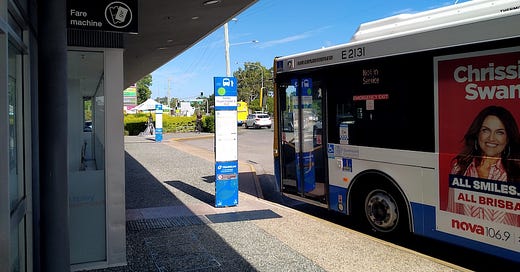Public Transport and the 50c Fare Trial
We examine the six-month trial of 50c fares for public transport, within the framework of Doughnut Economics. Could this be an opportunity to move towards a more sustainable, equitable future for all?
In August, the Queensland Government started a six-month trial of 50c fares for public transport as part of their cost-of-living relief package and in the hope that it will encourage more people to make the transition from private cars to public transport. (Queensland government press release)
Although there is a state election in October, both major parties are supporting this trial.
Why Moving to Public Transport is Important
Transport – cars, trucks, public transport, domestic flights and shipping – is Australia’s second largest source of greenhouse gas pollution. The sector emitted 102 million tonnes carbon dioxide (MtCO2) in 2018, representing 18% of Australia’s annual greenhouse gas pollution.
Transport emissions have the highest rate of growth of any sector since 1990. With no action, transport emissions are projected to continue growing to 2030 (expected to reach 111 MtCO2by 2030).
The major source of the problem is cars, responsible for roughly half of Australia’s greenhouse gas pollution from transport. In fact, Australian cars emit roughly the same per year as Queensland’s entire coal and gas fired electricity supply.https://www.climatecouncil.org.au/resources/transport-emissions-and-climate-solutions/
But is it that simple? Will simply lowering the fare mean that people will try public transport and then continue to use it after the trial? Would that have the long-term effects they claim?
Different stories
At Regen Brisbane, we look at the issue from different viewpoints to broaden the conversation about these complex issues. Click through to read the full articles and comment there, or comment on this post and the overall issue below.
reminds us that our lives and reasons for the choices we make are complex, and looks at the issue of transport within a circular economy framework. looks at how the language shapes the way people see the issue and looks at reducing fares for public transport within a Doughtnut Economics framework.In an older post,
shows the sort of reforms we need to make public transport work for communities in Brisbane’s northside. Fare reduction on its own, isn’t enough to make significant change, but could be part of the mix.Public transport is not just for commuters, and not just for residents, but for visitors as well.
provides some insights from her recent trip to Brisbane. The transport decisions we make now will shape how people move around the region during the 2032 Olympics.Opportunity or Flash in the Pan?
The outcomes of this trial will depend on the conversations around it, and how politicians, commentators, and community leaders manage those conversations. If we move in the direction of our conversations, we need conversations that will move us towards a more sustainable, equitable future for all.
So let’s grab the opportunity presented by this trial to look at transport within the Doughnut Economic framework, and start with some questions.
Some Starting Questions
What might it look like for everyone to have access to affordable transport?
How might public transport be able to provide the flexibility needed to allow for the multiple roles (worker, shiftworker, parent, carer, citizen, host, visitor) many of us play?
How might people of all ages, abilities and diverse backgrounds feel safe and supported using public transport?
How might the design of our housing complement a shift towards more sustainable transport?
How might we minimise the negative effects of the transport system on the planetary boundaries and even create positive environmental outcomes?
Please share your ideas in the comments. This is the first of a series of conversation starters we will publish on the complex issues we are facing in our region. Contact us if you’d like to participate or contribute a guest article.







I note both ‘sides’ of politics have come out saying they will keep 50c fares because patronage has surged. Which is great on the surface. The key question is what trips has the use of public transport displaced? If the cheap fares have caused a large mode shift from active transport that is not necessarily a positive. But if the mode shift was from cars to public transport that means the trial is achieving one of its stated aims. It would be great to get public data on this aspect of the trial.
You raise a good point about the conversation about public transport. I’ve been a bit pessimistic about the trial but that might be changing. Over the last week or so people I know have taken their first trips on public transport for many years. Everyone knows about the trial too. The trial has generated good publicity and good discussion among Queenslanders. Let’s hope the discussion continues.